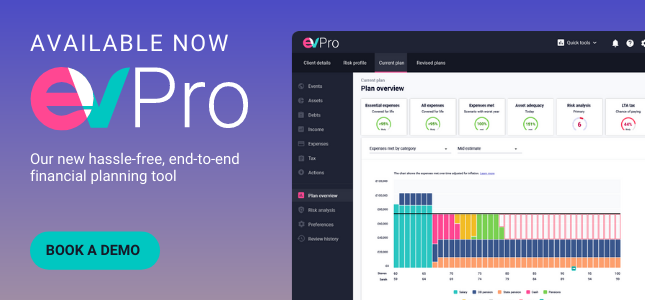Drawdown risk: rewriting the rule book

Investors face a fresh set of risks when drawing an income in retirement. Much of the remedial focus has been protecting non-advised consumers, but we must be careful not to neglect the needs of those taking advice. In this blog, we discuss re-writing the rule book to remedy these drawdown risks.
It’s hard to believe the Pension Freedoms were introduced more than six years ago. “No caps. No drawdown limits. Let me be clear: no one will have to buy an annuity,” is how then chancellor George Osborne announced the reforms in his 2014 Budget. Much has changed since, with a shift in popularity from annuities to flexible income drawdown by far the most prominent.
However, in some areas, the lack of change is a cause of concern. Consumers were quick to embrace the flexibilities afforded. In contrast, the industry has struggled to develop new tools and processes that take account of specific risks retirees are now facing.
The lack of innovation in this area is by no means a new concern. As far back as 2017, the Financial Conduct Authority (FCA) raised the matter in the interim report of its retirement outcomes market review. “We think that the incentives for innovating will increase over time as consumer [defined contribution] pots grow in size. We heard that some providers are already developing new product propositions. Again, we want to give the market further time to develop before we take any action,” the FCA said.
The regulator listed the main barriers to innovation as;
- The pace of policy change
- Uncertainty about how the market may develop
- Level of consumer inertia
- Most defined contribution pots were, at the time, reasonably small.
Almost four years on, and there is no shortage of evidence about how the market is developing. Between 2018 and 2020, drawdown sales outstripped annuity sales by roughly three to one.1
This, coupled with the scarcity of adequate innovation, puts retirees at risk of sleepwalking from the growth phase into retirement.
Remedying the drawdown risks
Risks specific to drawdown, such as sequencing returns and pound cost ravaging, can wreak havoc on the likelihood of an individual’s retirement pot lasting the distance.
Much of the remedial focus both for the regulator and broader industry has been protecting non-advised customers, launching initiatives such as investment pathways. While understandable - those not taking advice really do require the most support - we must be careful not to neglect the needs of those taking advice.
In most cases, consumers, whether taking advice or not, share the same objective: income sustainability. To clarify, by sustainable, we mean an individual continuing to withdraw the required level of retirement income for the required period.
Our industry has developed various risk questionnaires and cashflow modelling processes to help consumers devise a suitable investment strategy, understand their risk appetite and capacity for loss. But while risk processes for accumulation are well-established and subsequently widely used, there is no comparable system for decumulation. This is beset with problems. The dwindling number of defined-benefit pension arrangements offered to employees in the public sector means more and more retirees becoming heavily reliant on DC schemes to fund their retirement lifestyle.
The FCA’s 2017 review predicted that by 2030 £1.7trn will be held in DC workplace schemes, a five-fold increase from its figure of £340bn in 2015.2
For the industry to grasp the nettle here and provide consumers with adequate support in retirement, we feel the rules around drawdown risk need to be rewritten; current processes are not fit to serve those needing a sustainable income in retirement.
So, what needs to change here?
Firstly, address how current practices are falling short. Due to the absence of suitable methods of assessing their clients’ attitude to income risk and selecting appropriate risk-rated investments, advisers, not unnaturally edge towards investment strategies erring on the cautious side: bucket and “safe-siding“approaches, setting up cash reserves or buffers holding one to two years income to be dipped in market conditions where drawing equities is unfavourable. The main drawback here is the potential performance drag of any money held in cash misses out the potential upside during buoyant markets.
We’ve developed a complete risk-rating system for drawdown in recognition of this and arm advisers with adequate income-focused tools. This includes an income risk questionnaire, income risk ratings, efficiency ratings to reveal how well they deliver income, and risk descriptions for each risk profile to help advisers communicate the potential short-term outcomes and risk associated with each risk profile. Our income risk ratings and income questionnaire have been designed to dovetail with existing adviser decumulation processes, enabling them to complement rather than disrupt a firm’s current proposition.
The importance of having an income-focused risk rating system was, indeed, underlined during the development process. We compared the results of our growth and income questionnaires to try and understand how consumers approach each objective through a risk lens. Finding that consumers show a marked aversion to taking significant risks when investing for income rather than capital growth. It is imperative that risk rating tools take account of this caution to ensure the risk strategies recommended by advisers focus on the specific risks associated with income drawdown.
So what next?
If you found this information helpful and want to see how you can deliver better financial outcomes for your clients. Then, why not book your one-to-one demo of EVPro, ahead of launch by clicking the link below.
1 FCA - https://www.fca.org.uk/data/retirement-income-market-data - September 2020
2 FCA - https://www.fca.org.uk/publications/market-studies/retirement-outcomes-review - July 2017
